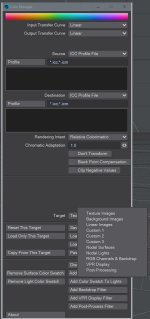raymondtrace
Founding member
Newly released/updated in the past day: Color Manager, now for LW2015 as well (LW2015-2020).
This can support a lot of color workflows, including ACES.
Don't forget OpenImageDenoise, also available for LW2015-2020. OIDN can offer better results than LW's GPU denoiser...and you don't need GPU for that.
Be sure to click the donations link at the bottom of his web pages.
This can support a lot of color workflows, including ACES.
The Color Manager module offers a main node working in all node editors with color input, primarily intended to transform and convert color images. This can be done globally through Color Manager Scene Master or locally with Color Manager node within any node editor. Both approaches could be mixed.
Don't forget OpenImageDenoise, also available for LW2015-2020. OIDN can offer better results than LW's GPU denoiser...and you don't need GPU for that.
Be sure to click the donations link at the bottom of his web pages.

